When 20-year-old Ranibai, from a poor family in Uttarakhand, began hemorrhaging during pregnancy, the path to treatment was not easy. Her family carried her on a charpai down hilly terrains to a health facility, but she bled to death before they got there. No health worker was nearby.
Ranibai's case is not an aberration. Tens of thousands of women are known to die of pregnancy and childbirth complications in India every year, but the actual number remains a mystery. For every woman who dies, another 20 to 30 suffer illnesses arising out of delivery or abortions.
An Indian Government estimate says the annual number of maternal deaths (deaths caused by pregnancy, delivery, or abortion) is 78,000, but a 2007 UN estimate puts the number at roughly 117,000, the highest number of maternal deaths in the world. But these are merely estimates with huge error margins. Women's health experts across the country agree that lack of accurate data is a big part of the problem.
Nine years ago, 189 countries came together and endorsed the United Nations General Assembly Millennium Declaration outlining eight millennium development goals (MDGs). Governments and donors have devoted intensive research, resources, and services to achieving these shared global priorities, but India is falling behind.
One of these goals, MDG-5, aims to reduce maternal mortality by 75 percent by 2015 from its 1990 levels. Even though about a fifth of maternal deaths worldwide are estimated to be in India, the government has not compiled up-to-date data on these often preventable tragedies.
The Indian government itself acknowledged that the "absence of reliable estimates" of maternal mortality makes the process of reducing it "both difficult and complex." The last nationwide study, which found that hemorrhage, infections, and unsafe abortions were the top three direct causes of maternal deaths, was for the period 1997 to 2003. There has been no reliable government study of maternal mortality since. For a country famed worldwide for its prowess in research, technology, and medical sophistication, this shows not a lack of capacity but a lack of political will.
Studies, such as the National Family and Health Survey and the District Level Household and Facility Survey, present useful information about access to antenatal and postnatal care, and whether women deliver at health institutions. But they do not tell us how many women die, where, and why, making it difficult to assess the impact of government's schemes and the progress on reducing maternal mortality.
Analysing maternal deaths, severe complications, and the medical, socio-economic, and cultural factors that contribute to them is critical to understanding and reducing maternal mortality. In Ranibai's case, hemorrhage was the direct cause of death. But a lack of transportation was a crucial contributing factor that denied her access to timely emergency obstetric care. There may have been other factors like poor nutrition, but no one will learn of them. The government, health-care workers, and women themselves will be unable to take more effective measures to prevent these deaths unless they have more and better information.
The most common method of monitoring adverse pregnancy outcomes is through confidential inquiries and reviews. The success of such techniques has been illustrated not only by various local nongovernmental and international organisations, but also by the Tamil Nadu state government.
Confidential inquiries empower women, their families, and health workers with a chance to be heard. Women in India not only suffer and die in alarming numbers, but they also suffer and die silently. Health workers strive in unenviable and harsh circumstances but are expected to churn out miraculous results. And bereaved families are often left with questions and complaints, but no realistic avenue for sharing them.
The disparities between those who can get luxury health care and those who struggle for the most basic care will not be resolved overnight. But tracking maternal deaths, severe complications, and their causes, and culling out lessons for change are essential first steps toward reducing that gap, and promoting the right to health, and life, for all Indian women.
Let us hope that someday very soon pregnant women in India no longer will die unseen, uncounted, and unheard. In the words of Renuka Chowdhury, the minister for women and child development, it would be a shame if in 2015 India presented itself on the global stage as "a country which can put Chandrayaan into orbit [but] cannot have women delivering babies (safely)."






